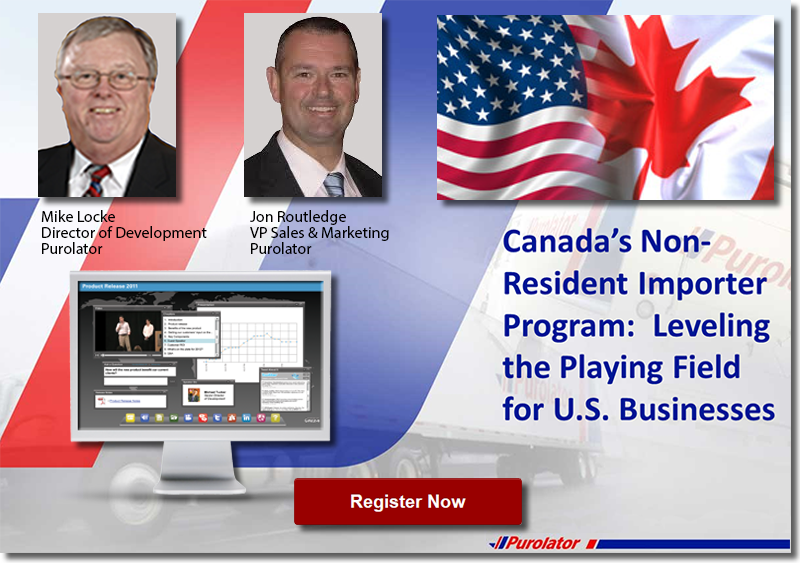When it Comes to NAFTA Benefits, not all Products are Created Equally

Although it’s generally understood that the North American Free Trade Agreement (NAFTA) eliminated tariffs on eligible products traveling between the United States, Canada, and Mexico, less understood is that not all products qualify for duty free treatment.
Determining which goods qualify for NAFTA benefits, and knowing how to initiate the process for claiming those benefits can be a highly confusing process.
A new white paper from Purolator International, “Understanding NAFTA and its Implications for U.S./Canada Trade,” offers a detailed overview for businesses that ship regularly to Canada, and want to ensure they take advantage of all available trade benefits.
As the paper makes clear, “origination” is the key factor in whether or not a product is eligible for duty free treatment. NAFTA provided for the elimination of all tariffs and most non-trade barriers on goods produced and traded within North America. But understanding if a product qualifies, or what percentage of a finished product’s component parts can be of non-NAFTA origin, can be an exceedingly intricate process. Failure to assign the proper tariff classification code – based on the Harmonized Tariff Code of the United States — can result in having to pay higher duty rates than necessary, or in missing out on trade agreement benefits.
Making NAFTA Work for You
A June 2010 study conducted by Customs & Trade Solutions, Inc. found businesses that invested the time to comply with a free trade agreement generally reported significant savings. Almost 30 percent of the survey respondents realized savings of $500,000 or more annually; 12.8 percent saved between $100,000 and $500,000; 7.7 percent saved between $50,000 and $100,000; and 16 percent saw savings or $50,000 per less.

Clearly, the financial benefits can justify the investment in time and resources spent ensuring accuracy in the filing of NAFTA Certificates of Origin. But given the exacting demands of NAFTA qualification, and the daunting penalties that can be assessed for inadvertently filing incorrect information, a business should integrate processes and standards.
To help clarify eligibility, NAFTA established “rules of origin,” that drill down into a product’s component parts. For every product, there is a rule of origin, but finding the appropriate rule — and applying the correct interpretation — can sometimes be challenging. For one thing, the rules are reviewed on a continual basis, so product eligibility may change over a period of time. Consider the following example from the U.S. Department of Commerce website:
A batch of cupcakes have been baked in the United States, but are comprised entirely of imported ingredients.
Cupcakes: Harmonized System Code: 1905.90
(In this example, the first two digits (19) are called the Chapter; the first four digits (1905) are called the Heading; and the first six digits (1905.90) are called the Subheading)
The first step to determine eligibility would be to look up the NAFTA rule of origin with regard to Chapter 19. In this example, the Rule states that a product is eligible for NAFTA preferential treatment if component parts are not also found in Chapter 19. For the sake of our cupcakes:
Flour – Chapter 1101
Sugar – Chapter 2102
Cocoa – Chapter 1806
Baking Soda – Chapter 2836
- Eggs: Chapter 0407
Therefore, because none of the ingredients fall under Chapter 19, the cupcakes are eligible for NAFTA benefits.
NAFTA recently marked the 20th anniversary of its implementation. The agreement has its supporters and critics, but it is undeniable that trade among the U.S., Canada and Mexico has increased dramatically during its period of implementation. As the agreement begins its third decade, businesses would be smart to avail themselves fully of its benefits and opportunities.
Want An Edge With Canadian Businesses? Become A Non-Resident Importer

Why Become a Non-Resident Importer?
As a Non-Resident Importer (NRI), a U.S. business acts as an “importer of record” and is able to have direct control over its shipments to Canada - offering unique access to the Canadian market. NRIs can charge their Canadian customers an all-included landed price at time of purchase while providing a streamlined customs clearance process, which ultimately leads to a great customer experience.
Download the Paper: Understanding NAFTA and its Implications for U.S./Canada Trade
Article Topics
Purolator News & Resources
What Happens When You Make a Customs Entry Mistake? Parcel experts raise key points about impact of coronavirus on express delivery-based markets Consolidation offers Faster Transit and Greater Efficiency for Canada-bound Shipments The Logistics of Canadian eCommerce How Cross Border Shippers Can Improve their Supply Chain Organizations New Research: How Cross Border Shippers Can Improve their Supply Chain Organizations Free Trade Agreements Drive Export Opportunities More PurolatorLatest in Supply Chain
April Employment Update: Trucking Sector Faces 300 Job Losses Porsche Gets Greener, Shifts to Sustainable Transport Logistics How Much Will it Cost to Repair Baltimore’s Francis Scott Key Bridge? Retailers Take Lead in Big-Box Warehouse Leasing, CBRE Finds Trucking Industry Pushes Back on Government’s Electric Mandates Senators Take Aim at Amazon with Warehouse Worker Protection Act Maersk Sees Silver Lining in Red Sea Shipping Challenges More Supply Chain













